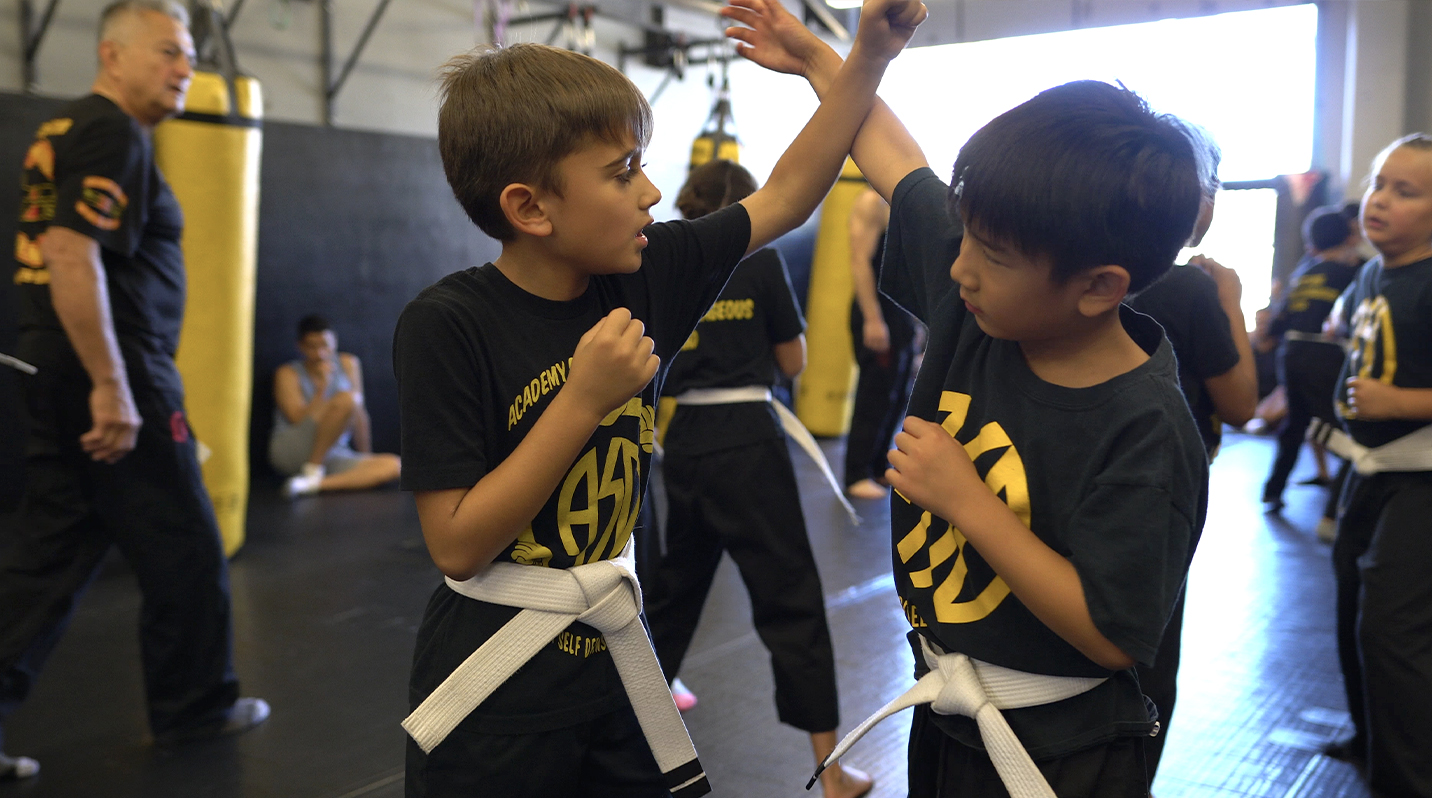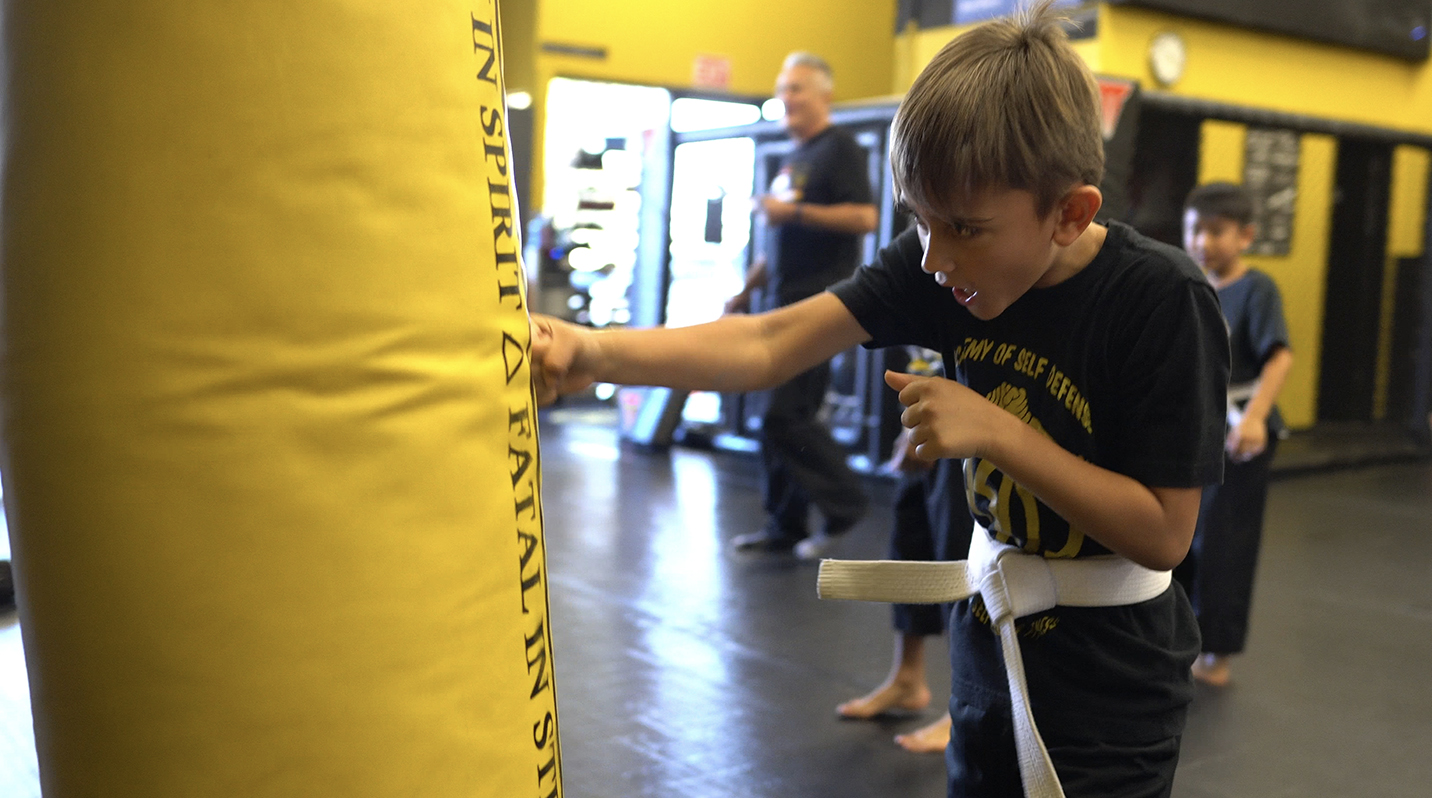
Though training in martial arts for kids looks like it’s about punching and kicking, it’s really about self confidence.
More than ever before, kids live in a world where they are surrounded by screens that call out to be something different, to numb themselves with whatever content a marketer is placing in front of them. Learning to find themselves and to find balance within the technology packed world that they live in is a challenge for today’s kids, and one that martial arts can help them meet. What happens in the dojo is a personal journey that’s grounded in the real world. Kids find that they are capable of more than they realize they are capable of, and this boosts their self confidence tremendously.

Focus on the individual
Lots of sports activities are team based, which puts the focus on competing with other kids. Martial arts is different because it focuses on the individual and their own growth. Though you are technically facing an opponent in sparring, the real opponent is always yourself. In martial arts, we measure our growth against ourselves, not against another person.
Our constant call in teaching or learning martial arts is to improve ourselves. Perform that kick more cleanly today than you did yesterday. Make that punch harder than your punch was yesterday. Get more grounded in your stance than you were last week.
Though there will always be other people who have influence on us, kids have to learn to be reliant on themselves and to grow for their own sake. This instills self reliance, which is a skill that translates out of the dojo and into school, work, and relationships. Closely tied to self reliance is personal responsibility, which is another central theme of martial arts for kids. At the end of the day, the only person who will be with a kid for their entire lives is themselves. With martial arts, kids learn that they can be confident in navigating the world independently.
Reaching for goals
Kids in martial arts learn to reach for specific goals. The self paced nature of martial arts training means that young people work with their coach or sensei to figure out what they want out of their training, then they create a path to get there.
This is incredibly helpful for kids who feel like they don’t belong anywhere. That kid who never seems to win at anything, who never feels like they live up to the expectations of teachers or classmates. In the dojo, kids progress through hard work and get to the next rank when they’re ready. They have specific skills to master – skills that are staggered to be reachable with each level they progress to.
All of this is structured through a routine that kids can access. That routine of training drives success, with skills broken down into pieces that they can get to. A single technique in martial arts is made up of many different parts, so in order to learn that technique it has to be broken down into parts. Once a kid learns each of those pieces, they learn to put them together and suddenly it all falls into place. Almost like magic! Breaking goals down in this way is a major life skill. Kids learn that they can master complex tasks if they slow down and break it up.

Attention and focus
Being able to anticipate what comes next is another skill that comes with martial arts training for kids. It’s not some mystic skill where children look into a crystal ball and suddenly know the future. Not at all. The martial arts mysticism in the movies is grounded in the real world skill of observing your environment. If you pay close attention to how someone moves and you’ve practiced doing this over and over with other people, then you learn that people move in patterns. If you figure out that pattern, then you can predict where they’ll go next. It comes down to focus and attention to detail.
Understanding the patterns that people replay over and over again is a major whole life skill. When you’re working in a job, you can predict how your boss or a client is going to react by observing their behavior beforehand. When you’re in a relationship, you can predict how your partner is going to act by paying attention to the way they behave. It’s not that different from watching an opponent and predicting when they’ll next throw a punch of a kick. At it’s heart, this is strategic thinking, and kids learn it on the mats in an organic way.
Observation is a skill that comes from learning to focus your attention. Kids have to stay focused in a martial arts program in order to learn the movements and then to do the movements. When a child’s focus drifts away from their training, instructors generally ask them to come back to their base stance. It calms the class down, but it also teaches them how to refocus their attention. Later on, when the instructor isn’t there, the child can come back to that lesson on how to bring their attention back to where they want it to be.
Structure and high expectations
The structure of martial arts training is rewarding and so helpful for kids. There are clear rules and high expectations in a dojo for how kids should act.
Martial arts classes for kids and adults are created in a way that reinforces the training. One example of how it might go is this: a bow in, a warm up, a lesson, sparring, and a cool down. Every class is going to go in this same way, allowing for everyone to know what to expect. That structure allows for growth within the training, giving space for kids to push themselves during class. The can focus their energy on techniques within the class because they don’t spend energy wondering what’s coming next.
Great martial arts instructors like those in our kids Krav Maga program know how to supportively push kids to become their best. The high expectations in the dojo build kids up because they learn that they can reach further than they knew was possible. Yes, you can do that roundhouse kick! Yes, you can master that punch/kick combo! Learning that they are capable of more than they realize is important inside and outside the dojo.

Structure and high expectations
The structure of martial arts training is rewarding and so helpful for kids. There are clear rules and high expectations in a dojo for how kids should act.
Martial arts classes for kids and adults are created in a way that reinforces the training. One example of how it might go is this: a bow in, a warm up, a lesson, sparring, and a cool down. Every class is going to go in this same way, allowing for everyone to know what to expect. That structure allows for growth within the training, giving space for kids to push themselves during class. The can focus their energy on techniques within the class because they don’t spend energy wondering what’s coming next.
Great martial arts instructors like those in our kids Krav Maga program know how to supportively push kids to become their best. The high expectations in the dojo build kids up because they learn that they can reach further than they knew was possible. Yes, you can do that roundhouse kick! Yes, you can master that punch/kick combo! Learning that they are capable of more than they realize is important inside and outside the dojo.

Kids grow through martial arts training, in big ways and small ways. The whole life skills that kids learn through Krav Maga help them to succeed in school, in work, and in relationships.
Explore our Kids Krav Maga Classes
Kids Krav Maga and other family-friendly fitness classes are available online, in-person, and on demand! We have over 100+ weekly classes and 5000+ videos on demand!